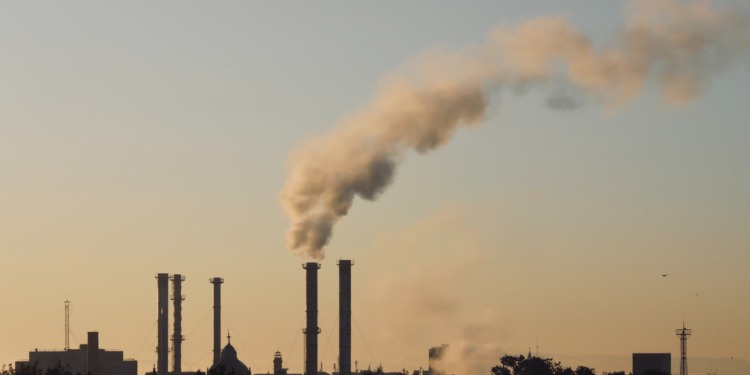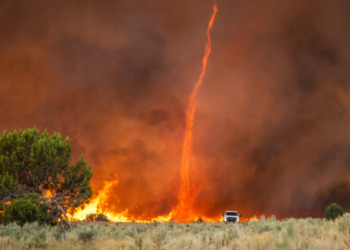Starting from Japan’s Disaster Relief Act dating back to 1947, to Biden’s Inflation Reduction Act implemented just last year, here are some of the most significant steps the world has adopted to fight climate change.
These climate laws and policies are all included in a database recently compiled by the Grantham Research Institute at the London School of Economics and the Sabin Center at Columbia Law School, encompassing 3150 laws and policies in total (as of April 17).
The database covers energy, transport, economy-wide issues, land use and forestry issues.
Japan’s Disaster Relief Act is the oldest policy included in the database.
Japan’s Disaster Relief Act
Japan’s Disaster Relief Act of 1947 marked one of the first disaster relief frameworks still relevant today. It was enacted in response to the fast devastation caused by the Second World War and subsequent natural disasters such as hurricanes and floodings; events which the country is prone to and that have been exacerbated by climate change.
In 1947, climate change wasn’t yet the issue it is today, yet the Disaster Relief Act has paved the way for multiple laws since that have played a key role in the country’s fight against climate change and its repercussions.
Clean Air Act
The Clean Air Act is a federal Law in the USA, first enacted in 1963 and amended several times since to expand its regulating authority.
The act has often been credited for the drastic improvement in air quality in the US, as well as for providing the necessary framework to address other climate-change-related issues.
The primary purpose of the Clean Air Act was to drastically decrease air pollution by expanding research into the impact of different industries on air quality and implementing a new public health program.
Although the Clean Air Act was not implemented to address climate change directly, it has provided a framework that has been expanded multiple times since 1963, notably in 1970, 1977 and 1990.
In 1970, the Clean Air Act provided the Environmental Protection Agency (EPA) with the authority to regulate the quality of the air by monitoring polluting industries and the air pollutants released.
This Day in Labor History: October 27, 1948. An air inversion trapped the pollution spewed out by U.S. Steel-owned factories in Donora, Pennsylvania. 20 people died and 6,000 got sick. Let's talk about the Donora Smog and the legacy of pollution in the working class! pic.twitter.com/ZOHgFutu0X
— Erik Loomis (@ErikLoomis) October 27, 2022
The flexible wording of the act made it relevant for future technologies and problems such as climate change and CO2 pollution, which were not yet seen as imminent sources of danger.
As such, the amendment of 1990 could be geared towards the phase-out of chemicals depleting the ozone layer, implement a national permits program and control acid rain.
The Natural Resource Defense Council (NRDC) has also found that by 2030, “programs under the 1990 amendments will have lowered the amount of CO2 and methane emissions enough to avoid $63 billion in climate-related economic damages annually.”
These climate laws are the foundation to fight the current crisishttps://t.co/aq8YcoHVmR
— World Economic Forum (@wef) April 17, 2023
Montreal Protocol
The Montreal Protocol is one of the first international treaties that laid the foundation for the global fight against climate change. It aimed to protect the ozone layer by phasing out the production and consumption of substances that deplete it, such as chlorofluorocarbons (CFCs).
Aside from successfully eliminating nearly 99% of these harmful substances, the Protocol has also been extended through the Kigali Amendment to reduce the production of hydrofluorocarbons (HCFCs). HCFCs are powerful greenhouse gases (GHGs) that contribute significantly to climate change, as the most commonly used HCFC is 2,000 more deleterious than carbon dioxide in its global warming potential (GWP).
The Montreal Protocol is one of the rare treaties that has been ratified by every country in the world, although not immediately: This can partially be attributed to its two distinct step-by-step timetables adapted to developed and developing countries, respectively. Developed countries pledged to completely phase out HCFCs by 2020, while developing countries have until 2030 to complete the phase-out.
UNFCCC
The UN Framework Convention on Climate Change (UNFCCC) was created in 1992 and has been ratified by 197 countries since, including the US. The accord was the first treaty aimed directly at mitigating and fighting climate change, establishing the annual forum for climate change discussion, the Conference of the Parties (COP).
Related Articles: Clean Power in 2023: ‘An Era of Fossil Decline Is About to Begin’ | G7 Meeting on Climate and Energy in Japan: Will the World Now Pivot to Solar and Wind? | Sea Levels Rising Much Higher Than Previously Anticipated
The COP provides a platform for countries to discuss and coordinate their efforts to address climate change, share information and learn from each other’s experiences. It is an opportunity for countries to make commitments, set targets and provide updates on their progress towards achieving their climate goals.
The UNFCCC thus paved the way for vital international agreements that have set the tone for the fight against climate change and influenced national climate action plans worldwide.
Kyoto Protocol
Amongst the success of the UNFCC is the Kyoto Protocol, which was adopted in 1997 and came into force in 2005. It was the first treaty to set legally binding emissions reduction targets for developed countries, requiring them to collectively reduce their GHG emissions by 5.2% below their 1990 levels between 2008-2012, and established a system to monitor countries’ progress.
The treaty was quite successful in the EU, achieving a 19% reduction below the base year of 1990, while the EU-15, comprised of the EU members in 1995, achieved an 11.7% cut domestically.
On the other hand, Japan, Canada and Russia withdrew from the treaty, while the US never ratified it due to internal political struggles.
Additionally, the Protocol did not require many developing countries to reduce their emissions, such as China and India at the time of the protocol, which are now major GHG emitters.
As such, the Protocol was then replaced by an even more important agreement, the Paris Agreement of 2015.
Paris Agreement
The Paris Agreement is one of the most influential treaties of this century. Signed in 2015 at COP21 in France, it aims to prevent global average temperatures from exceeding 2°C above the pre-industrial level by pursuing levels to keep it below 1.5°C instead.
Under the Paris Agreement, countries are required to set their own voluntary targets for reducing GHG emissions and submit regular reports on their progress, aiming to reach global net-zero emissions in the second half of the century, where the amount of GHGs emitted into the atmosphere equals the amount removed.
The agreement also establishes a framework for international cooperation to support developing countries in their efforts to mitigate and adapt to the impacts of climate change.
As of 2021, 197 countries have signed the Paris Agreement, and 195 have ratified it. The United States, which had initially signed the agreement, withdrew under the Trump administration but has since rejoined under the Biden administration.
EU Renewable Energy Directive
Aside from adhering to international treaties and targets, the EU has set multiple targets internally to fight climate change, notably its Renewable Energy Directive. The legislation enacted in 2009 aims to promote the use of renewable energy sources and increase their share in the overall energy mix.
The directive sets binding targets for EU member states to increase the share of renewable energy in their final energy consumption, such as heating and electricity, to 20% by 2020 and 32% by 2030.
The Renewable Energy Directive has been legally binding since June 2021
Since its introduction, the use of renewable energy has been growing yearly, reaching 21.8% in 2021. According to Eurostat, Sweden has the highest share of renewables consumption at 62.6% in 2021, followed by Finland at 43.1% and Latvia at 42.1%.
European Green Deal
The European Green Deal is a comprehensive policy package launched in December 2019, aimed at making the EU climate neutral by 2050.
The Green Deal sets out a wide range of initiatives and policies designed to transform the EU into a sustainable and competitive economy, while addressing the urgent challenge of climate change and environmental degradation.
To achieve carbon neutrality, the EU set out to reach net-zero GHG emissions by 2050, increase the EU’s 2030 emission reduction target from at least 40% to at least 55% and scale-up renewable energy and energy efficiency measures.
Inflation Reduction Act
In August 2022, the Biden administration passed the Inflation Reduction Act, regarded as the most important climate action in US history.
The Inflation Reduction Act of 2022 allocates $369 billion towards reducing GHG emissions and fighting climate change.
The legislation includes tax credits and funds for transportation electrification, such as $3 billion for the electrification of the U.S. Postal Service’s fleet and $3 billion for reducing pollution at ports. The bill also aims to reduce emissions from heavy-duty vehicles, including school buses and garbage trucks.
Over $200bn in green tech and semiconductor investments have been announced since the passage of the Inflation Reduction Act & Chips Act. CC: @FT pic.twitter.com/4RsSbzHCL7
— Steven Rattner (@SteveRattner) April 17, 2023
The goal is to reduce GHG emissions by 40% below 2005 levels by 2030, bringing the US closer to its climate goals under the Paris Agreement.
An analysis by Rhodium Group, an independent analyst firm focusing on economic data and global trends, estimates that the bill could reduce GHG emissions by 31% to 44% by 2030, compared to a previous estimate of 24% to 35%.
According to the American Clean Power Association’s analysis, the bill would increase the production of clean power in the country by over three times, resulting in an additional 550 gigawatts clean energy produced. The industry trade group noted that this amount of electricity would be sufficient to power 110 million homes.
Looking Ahead
As we are now anticipating COP28, due to take place later this year in November in Dubai, it is important to remember the successes and failures of past international cooperation attempts and learn from them. Climate change laws and policies are now the centrepiece of many legislative landscapes throughout the world and need to be shaped both on a national and global level.
Editor’s Note: The opinions expressed here by the authors are their own, not those of Impakter.com — In the Featured Photo: Smoke coming out of Plant Featured Photo Credit: Cristi Goia









